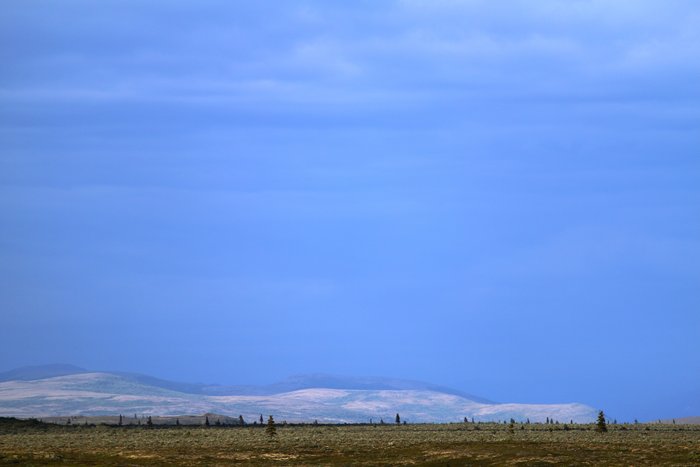
Background
The controversial Pebble Mine prospect has provoked a large amount of press within Alaska due to its size, profit potential, and the risk it presents to essential salmon habitat. The potential for the development of other large mines nearby greatly magnifies the positive and negative impacts of this mine. Mining claims in the immediate vicinity cover over 500,000 acres, and are held by a number of different companies (see below). Developing these nearby prospects could help sustain longer term economic benefits of the mining infrastructure needed at Pebble, but they could also create cumulative environmental impacts that compound the impact of individual mines.
Infrastructure

There is currently little to no mining infrastructure in this region, and the cost to build it would be high. If the Pebble Mine development goes forward as planned, the accompanying roads, port, and access to electrical power would dramatically lower the economic barriers to entry for opening nearby mining claims. Other mines could benefit directly from the use of Pebble’s infrastructure, as well as indirectly from an increase in mining expertise and experience in the region.
Cumulative impacts
This piggybacking effect could significantly amplify impacts on water quality and fisheries in the region. In the “best-case” scenario, each mine would impact the environment with limited scope and the total effect on the region would be no more than the sum of the effects of individual mines. This could still include problems such as acid mine drainage, habitat destruction, and negative impacts on water quality in the region. However, with each additional mine, the risks of a catastrophic failure such as an acid-containing tailings dam collapse, increases and the impacts on water quality in the Bristol Bay watershed add up. Likewise, each mine would most likely destroy or negatively impact some amount of fish habitat nearby. Because of the vital importance of maintaining genetic diversity of salmon stocks, extensive mining in this area puts at risk the most productive salmon fishery in the world.

Developing these nearby prospects could help sustain longer term economic benefits of the mining infrastructure needed at Pebble Mine, but they could also create cumulative environmental impacts that compound the impact of individual mines.
 — 
<a class="figure-caption__link" href="/photos/mining-claims-near-pebble/">Get Photo</a></figcaption></figure>Mining Companies
Alaska Earth Resources Inc. , a small, Alaska-based organization (owned by the same principles as Alaska Earth Sciences Inc.), has staked out a couple of small claims near the Pebble Prospect. The initial filing of these claims, in 2003, sparked a “claims rush” which resulted in the filing of claims on several hundred thousand nearby acres within a month. The company has worked in collaboration with Canadian-based Full Metal Minerals Inc. to explore these claims in more detail.
Big Chunk Corporation owns a large collection of mining claims to the north and west of the Pebble deposit. Big Chunk was originally a subsidiary of Liberty Star Nevada, which merged with Liberty Star Acquisition Corp, in 2004, to become part of the Liberty Star Gold Corporation (now the Arizona-based Liberty Star Uranium and Metals Corporation). In 2009, Liberty Star concluded a series of geophysical studies and announced they had found several large mineral deposits on their claims. In July 2010, Liberty Star sold 23 square miles of claims adjacent to the Pebble claims to Northern Dynasty Minerals, one of the 50/50 partners in the Pebble Limited Partnership, in order to pay off company debt.
Full Metal Minerals Inc., a Canadian-based junior mining exploration company, holds a number of mining claims to the south and east of the Pebble claims. Full Metal Minerals is involved in a several exploration projects throughout Alaska, including a cooperative venturewith Kinross Gold (which operates the Fort Knox Mine in Interior Alaska). Full Metal Minerals has performed preliminary exploration of the mining claims near Pebble (called “Pebble South”) which is now a joint project with the Pebble Limited Partnership.
Groundhog Mines LLC and Nika Mines LLC own two large blocks of claims to the northwest of the Pebble deposit, but, in August 2009, both filed for Chapter 11 bankruptcy in Anchorage. According to the AK DNR industry report, exploration took place on the Groundhog claims in 2010 by Kennecott Exploration Co. and Alaska Earth Sciences. The claims previously owned by Groundhog Mines LLC are now owned by Alaska Earth Sciences. In early 2015, Kijik Native Corporation announced a partnership with Alaska Earth Sciences to explore developing Groundhog Mountain - raising strong objections from Nondalton, one of its constituent villages.
On-line Exploration Services Inc. , a small, Alaskan-based mineral engineering and geological consulting firm, owns five different blocks of mining claims near the Pebble claims.
Pebble Limited Partnership, a 50/50 partnership between Canadian-based Northern Dynasty Minerals and UK-based Anglo American, owns the “Pebble East” and “Pebble West” blocks of mining claims that together comprise the controversial Pebble Mine proposal. In 2011 they purchased the “Pebble South” claims as well.
Stuy Mines LLC owns a small block of mining claims well to the southwest of the Pebble Deposit. The company is registered in Washington State and is most likely affiliated with Groundhog Mines LLC and Nika Mines LLC. In late 2009, the company applied for permission to conduct basic drilling exploration on these claims.
Created: Jan. 19, 2018